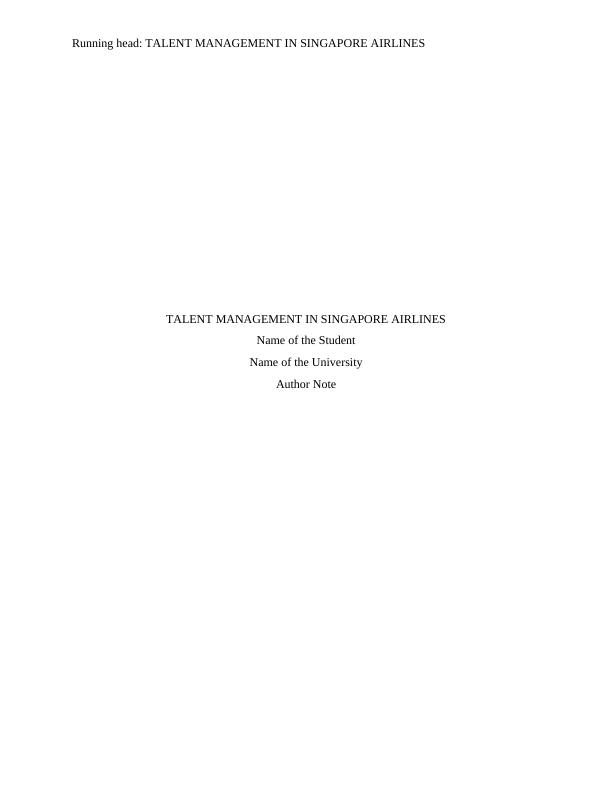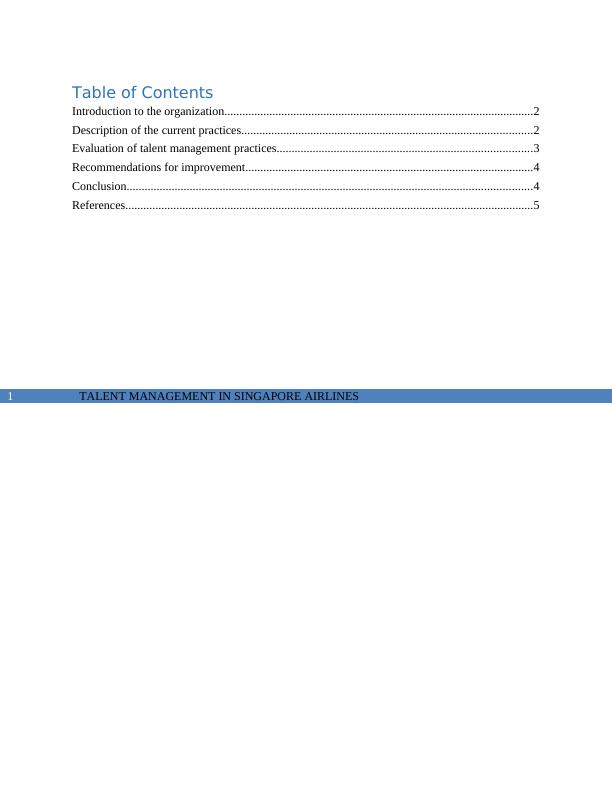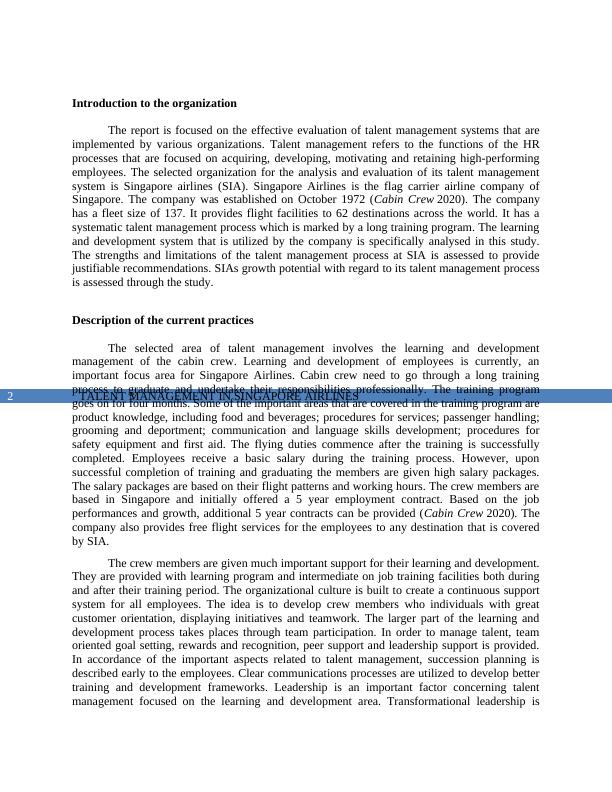Talent Management in Singapore Airlines | Report
Added on 2022-08-17
6 Pages2009 Words17 Views
Running head: TALENT MANAGEMENT IN SINGAPORE AIRLINES
TALENT MANAGEMENT IN SINGAPORE AIRLINES
Name of the Student
Name of the University
Author Note
TALENT MANAGEMENT IN SINGAPORE AIRLINES
Name of the Student
Name of the University
Author Note

TALENT MANAGEMENT IN SINGAPORE AIRLINES1
Table of Contents
Introduction to the organization.......................................................................................................2
Description of the current practices.................................................................................................2
Evaluation of talent management practices.....................................................................................3
Recommendations for improvement................................................................................................4
Conclusion.......................................................................................................................................4
References........................................................................................................................................5
Table of Contents
Introduction to the organization.......................................................................................................2
Description of the current practices.................................................................................................2
Evaluation of talent management practices.....................................................................................3
Recommendations for improvement................................................................................................4
Conclusion.......................................................................................................................................4
References........................................................................................................................................5

TALENT MANAGEMENT IN SINGAPORE AIRLINES2
Introduction to the organization
The report is focused on the effective evaluation of talent management systems that are
implemented by various organizations. Talent management refers to the functions of the HR
processes that are focused on acquiring, developing, motivating and retaining high-performing
employees. The selected organization for the analysis and evaluation of its talent management
system is Singapore airlines (SIA). Singapore Airlines is the flag carrier airline company of
Singapore. The company was established on October 1972 (Cabin Crew 2020). The company
has a fleet size of 137. It provides flight facilities to 62 destinations across the world. It has a
systematic talent management process which is marked by a long training program. The learning
and development system that is utilized by the company is specifically analysed in this study.
The strengths and limitations of the talent management process at SIA is assessed to provide
justifiable recommendations. SIAs growth potential with regard to its talent management process
is assessed through the study.
Description of the current practices
The selected area of talent management involves the learning and development
management of the cabin crew. Learning and development of employees is currently, an
important focus area for Singapore Airlines. Cabin crew need to go through a long training
process to graduate and undertake their responsibilities professionally. The training program
goes on for four months. Some of the important areas that are covered in the training program are
product knowledge, including food and beverages; procedures for services; passenger handling;
grooming and deportment; communication and language skills development; procedures for
safety equipment and first aid. The flying duties commence after the training is successfully
completed. Employees receive a basic salary during the training process. However, upon
successful completion of training and graduating the members are given high salary packages.
The salary packages are based on their flight patterns and working hours. The crew members are
based in Singapore and initially offered a 5 year employment contract. Based on the job
performances and growth, additional 5 year contracts can be provided (Cabin Crew 2020). The
company also provides free flight services for the employees to any destination that is covered
by SIA.
The crew members are given much important support for their learning and development.
They are provided with learning program and intermediate on job training facilities both during
and after their training period. The organizational culture is built to create a continuous support
system for all employees. The idea is to develop crew members who individuals with great
customer orientation, displaying initiatives and teamwork. The larger part of the learning and
development process takes places through team participation. In order to manage talent, team
oriented goal setting, rewards and recognition, peer support and leadership support is provided.
In accordance of the important aspects related to talent management, succession planning is
described early to the employees. Clear communications processes are utilized to develop better
training and development frameworks. Leadership is an important factor concerning talent
management focused on the learning and development area. Transformational leadership is
Introduction to the organization
The report is focused on the effective evaluation of talent management systems that are
implemented by various organizations. Talent management refers to the functions of the HR
processes that are focused on acquiring, developing, motivating and retaining high-performing
employees. The selected organization for the analysis and evaluation of its talent management
system is Singapore airlines (SIA). Singapore Airlines is the flag carrier airline company of
Singapore. The company was established on October 1972 (Cabin Crew 2020). The company
has a fleet size of 137. It provides flight facilities to 62 destinations across the world. It has a
systematic talent management process which is marked by a long training program. The learning
and development system that is utilized by the company is specifically analysed in this study.
The strengths and limitations of the talent management process at SIA is assessed to provide
justifiable recommendations. SIAs growth potential with regard to its talent management process
is assessed through the study.
Description of the current practices
The selected area of talent management involves the learning and development
management of the cabin crew. Learning and development of employees is currently, an
important focus area for Singapore Airlines. Cabin crew need to go through a long training
process to graduate and undertake their responsibilities professionally. The training program
goes on for four months. Some of the important areas that are covered in the training program are
product knowledge, including food and beverages; procedures for services; passenger handling;
grooming and deportment; communication and language skills development; procedures for
safety equipment and first aid. The flying duties commence after the training is successfully
completed. Employees receive a basic salary during the training process. However, upon
successful completion of training and graduating the members are given high salary packages.
The salary packages are based on their flight patterns and working hours. The crew members are
based in Singapore and initially offered a 5 year employment contract. Based on the job
performances and growth, additional 5 year contracts can be provided (Cabin Crew 2020). The
company also provides free flight services for the employees to any destination that is covered
by SIA.
The crew members are given much important support for their learning and development.
They are provided with learning program and intermediate on job training facilities both during
and after their training period. The organizational culture is built to create a continuous support
system for all employees. The idea is to develop crew members who individuals with great
customer orientation, displaying initiatives and teamwork. The larger part of the learning and
development process takes places through team participation. In order to manage talent, team
oriented goal setting, rewards and recognition, peer support and leadership support is provided.
In accordance of the important aspects related to talent management, succession planning is
described early to the employees. Clear communications processes are utilized to develop better
training and development frameworks. Leadership is an important factor concerning talent
management focused on the learning and development area. Transformational leadership is

End of preview
Want to access all the pages? Upload your documents or become a member.
Related Documents
A Report on Airline Business in Singapore: A Case Study of Singapore Airlineslg...
|10
|2788
|124
Internal Value Chain of Singapore Airlineslg...
|4
|733
|54
Explanation and Implementation of Contemporary HRM Practices in Singapore Airlineslg...
|11
|3016
|189
Corporate culture/philosophy And Managerial Aspectslg...
|12
|2400
|11
NRS-451V Singapore Airlines Case Studylg...
|5
|1478
|121
Airline Business in Singapore: Singapore Airlines – A Case Studylg...
|12
|2943
|291
